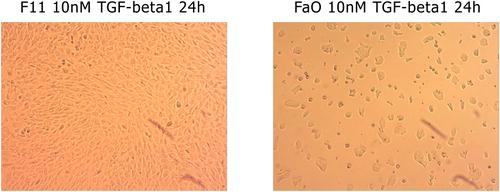A key player in the fibrotic process is the transforming growth factor β (TGF-β) which enhances extracellular matrix production by increasing the transcription of matrix proteins. The cytokine TGF-β first binds to the TGFβRII receptor (dimer), resulting in the recruitment of the TGFβRI receptor (dimer). The complex thus formed leads to the phosphorylation of the kinase domain of TGFβRI, which in turn results in activation of the Smad pathway. This is therefore a targeted pathway for research into the application of peptide inhibitors in blocking the TGF-β-Smad signaling pathway. The aim of this study was to design a peptide inhibitor (homologous to the cytokine TGF-β) which, after binding to the TGFβRI/TGFβRII receptor, would block the cytokine binding and thus prevent the formation of an activating complex.
Preliminary work on the design and synthesis of inhibitors for TGFβRI/TGFβRII has allowed us to identify and describe five key regions of the TGF-β—TGFβRI/TGFβRII interface. The following five peptide inhibitors were synthesized for Region 1: 1.1 ALDAAYCFR, 1.2 LDAAYCFRN, 1.3 DAAYCFRNV, 1.4 AAYCFRNVQ, 1.5 AYCFRNVQD. The expression of the SEAP reporter gene, Smad2, Smad3, Smad4, and JNK1 gene was measured using quantitative real-time polymerase chain reaction.
For Region 1 peptide inhibitors tested for TGFβRI/TGFβRII, reduced SEAP (reporter gene) expression was observed in cells of the MFB-F11 line, which suggests inhibited the formation of cytokine-receptor complexes.
For IP1_2, 1_3 and 1_5 Region 1 peptides tested for TGFβRI/TGFβRII, reduced cytokine-receptor signal by adding newly designed inhibitors. The study revealed an impact of these peptide inhibitors on the reduction of mRNA expression of Smad2, Smad3, Smad4 and JNK1 genes.



